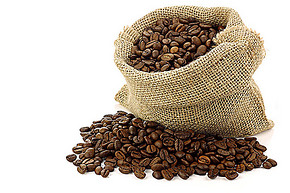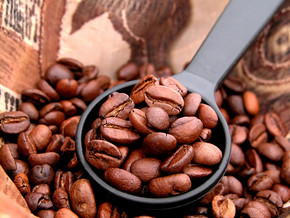Brief introduction of Sidamo Coffee Bean
Follow the caf é (Wechat official account vdailycom) and found that Beautiful Cafe opened a small shop of its own.
Country profile:
Country name: Democratic Federal Republic of Ethiopia (Ethiopia for short)
Location: located in the plateau of northeast Africa.
Neighbouring countries: North-Eritrea (Erithrea), South-Kenya (Kenya), East-Somalia (Somalia) 'Djibouti (Djibouti), West-Sudan (Sudan)
Land area and condition: 1127127 square kilometers, almost three times the size of California (about 34 times the size of Taiwan), the territory is mountainous, due to frequent earthquakes, there are many fault longitudinal valleys in the plateau, and the topography forms a strong contrast. the desert is located in the southwest border (Kalahari) and the north (Sahara), near the coastline is a hot lowland of short bushes, the country is almost plateau mountains. The average elevation is 2500-3000 meters, and the territory is connected by several high mountains in a network. There is Lake Tana in the northwest plateau, which is the source of the Nile River, from which the lake forms a semicircular clockwise flow out of the mountain valley until it flows out of Sudan. The Sahara Desert covers part of the area and is rich in mineral reserves, known as the Horn of Africa.

Capital: Addis Abeba, Adis, 2200186 people
Population: 67673031 (2002), growth rate 2.6%, birth rate 44.3, infant mortality 98.6, 000, population density: 81 per square mile
Language: Amharic (official), and about 70 local dialects
Race: Oromo 40%, Amhara and Tigrean 32%, Sidamo 9%, Shankella 6%, Somali 6% Shankella 4%, Gurage 2%, other 1%
Religion: Ethiopian Orthodox 35% Mel 40%, Islam 40% Mel 45%, animist 15% Mel 20%, other 5%
Literacy rate: 28% (1984)
National currency: Birr
International Standard time: Greenwich Mean Time + 3
Export port and transportation: the country's non-coastal countries are mainly from the neighboring Assab port of Erithrea and the Djibouti port of Djibouti, with a railway of 681km (from the capital to the port of Djibouti).
Economic profile: GDP- US $39.2 billion (2002), average annual personal income of US $400,2% economic growth rate, 5% inflation rate
Agriculture and animal husbandry accounted for 80%, government agencies accounted for 12%, and industry accounted for 8%.
General situation of agriculture and animal husbandry: arable land-12%, farming-grain, coffee, rape, sugar cane, potato, livestock-cattle, sheep, goat.
Industry: food processing, textile, metal processing, chemistry, cement
Natural resources: platinum, copper, gold, potassium carbonate, natural gas
Exports: coffee, gold, leather products, rape, furs and legumes, with a total value of about US $460 million
--
Coffee profile:
The total planting area is about 400000 hectares, all of which are planted by Elaraby, 94% are small farms, 6% are government agencies, and the number of farmers is about 12000000.
The rainy season is from January to February, followed by the dry season.
Domestic production areas: Illubabor, Kaffa, Gambela, Wollega, Asosa, Sidamo, Borena,West and East Harrar
Common names: Sidamo, Yirgacheffe, Limu, Bebeka non-wash-Harrar, Sidamo, Djimmah, Lekempti (wild)
Harvest season: washing-October to March, non-washing-end of July to December
The annual output is about 3833000bags/60kg (second in Africa and tenth in the world).
Today, there are still a large number of wild Arabica coffee trees growing in many parts of Ethiopia, averaging between 4200 and 6800 feet above sea level. Now there is a trend of small cultivation, generally planting banana trees for shade at the same time, but due to lack of agricultural technology, herbicides and pesticides are less used.
Coffee is Ethiopia's main economic crop and the country's largest crop export and important industry. It accounts for 60% of Ethiopia's total export value and supports many small farms, as well as sugar, bananas and cotton. It is also Ethiopia's largest and important commodity export crop after oil, and it is also the largest export of Elaraby in Africa, with a total value of about US $300 million in 1997. in terms of total production, 94% are small farms and 6% are government agencies. because many farms are scattered and grow other crops, it has been difficult to integrate the figures correctly. However, the country's official coffee cultivation area is at least 400000 hectares, and the Ethiopian government encourages local farmers to improve their quality and productivity so that coffee farmers can expand their business scale and increase production capacity and exports.
During the harvest, farmers harvest fresh red fruit every day, and every two days the coffee fruit is sent as a unit or sold to a water washing plant for treatment. coffee fruit without a water treatment plant is usually naturally fermented for about 12 hours, and then passed through the sun for drying and shelling. in any case, farmers always try their best to send them to the water treatment plant for treatment. In order to sell better under the name of "washing treatment", in the water wash, coffee cherries soften the pulp after soaking and fermenting for about 12 hours, then pass through the waterway and stir to separate the pulp from the coffee beans. the pulp is discharged with the floodgates, while coffee beans need six days of sunshine to dry, but the processing time is only from sunrise to 11:00 and from 03:00 to sunset. The water content of raw beans after treatment should be about 12% ~ 12.5%. After selecting residual or shoddy beans, they are packed in sacks and trucked to the coffee auction house in the capital, Addis Ababa.
There are many water treatment plants on the main roads of coffee producing areas, especially in Jima area, and a large number of treatment plants are not fully utilized because of the fierce competition, so the person in charge of the treatment plant pays a higher price to the farmers, but worries about whether they can make a profit. Nowadays, a kilogram of raw beans usually sells for about 2 Birr (Ethiopian units). During the whole harvest period, the employees of the treatment plant worked for two months without a rest day, with a daily capacity of about ten bags per plant.
There are institutions such as research institutes in Jima, and farmers are taught to introduce new technologies and apply green manure crops to reduce fertilizer costs and improve the seeds of new varieties, so that coffee trees can have stronger resistance. the seeds are cultivated and grown for a year before they are resold to farmers, who use improved seeds and methods to plant them until the seventh year. The difference is that in the past, yields were about 600lbs per hectare, but improved yields could reach 1000 pounds per hectare, and the agency even guaranteed yields of at least 700lbs per hectare.
There are several other coffee cooperation organizations in Gima, where members share water and fertilizers, and few members are deprived of their wages under their organizations and provide health insurance for each member.
The state-owned farm has about 21000 hectares, and there are five large farms located in TEPI and BEBEKA. The area is close to Jima but most of them belong to lower areas. Each single farm occupies at least 1050 hectares of land. During the production period, the farm owner uses about 3000 long-term workers and about 3000 temporary employees, and the farm has its own washing plant. Its capacity is about 6000 pounds of raw beans per hour, and the higher quality raw beans are washed. Each kilogram can be sold by 32Birr, and the farm warehouse can store 300000 pounds.
Nowadays, there are more and more water washing treatment plants in Ethiopia. Small farmers sell the harvested coffee fruit to the processing plant, peel it and resell it in the auction system, and then transfer it to the port of Assab in Eritrea in the Red Sea and the port of Djibouti in Djibouti near the Bay of Aden. The coffee is the country's main agricultural export, but its own annual consumption is also astonishing, about 1500000bags/60kg. Accounted for 50% of the total generation. Wild coffee grows in the tropical rain forests of the southwestern plateau, and most of them are selected by hand, but because of this, many local people maliciously destroy the naturally formed rainforest areas-either felled or burned in order to reach the rugged mountains that are inaccessible. But it seriously affected the ecological balance.
Whether it is raw coffee washed or sunburned, all exported coffee is sent to the capital, Addis Ababa, and the DIRE DAWA auction exit in Hara province. The DIRE DAWA auction center usually exports sunburn halas in the area. Coffee information from different farms can be seen in the auction house every day to facilitate the purchase of traders. Several officials from Ethiopia also go in and out of the center every day to inspect and set grades. Each time a random sample of the same shipment of raw beans 3 kg inspection.
Important Notice :
前街咖啡 FrontStreet Coffee has moved to new addredd:
FrontStreet Coffee Address: 315,Donghua East Road,GuangZhou
Tel:020 38364473
- Prev

The types of Starbucks coffee beans
Following Cafe Review (Wechat official account vdailycom) found that Starbucks Coffee NO.1 Cappuccino Cappuccino has opened its own small shop. This coffee is made by our skilled coffee bartenders who gently pour hand-made hot milk and delicate foam over espresso. In Italy, cappuccino is usually regarded as breakfast drink
- Next

The main culture of Sidamo coffee beans
Following caf é (Wechat official account vdailycom) found that Coffee Cafe opened a small shop of its own coffee culture: from a historical point of view, coffee has a lot to do with the history and religious culture of Ethiopia. In ancient times, Ethiopia was called Abyssinia and Axum, which was ruled by the Solomon Dynasty. According to the literature, it contains Mitt.
Related
- Detailed explanation of Jadeite planting Land in Panamanian Jadeite Manor introduction to the grading system of Jadeite competitive bidding, Red bid, Green bid and Rose Summer
- Story of Coffee planting in Brenka region of Costa Rica Stonehenge Manor anaerobic heavy honey treatment of flavor mouth
- What's on the barrel of Blue Mountain Coffee beans?
- Can American coffee also pull flowers? How to use hot American style to pull out a good-looking pattern?
- Can you make a cold extract with coffee beans? What is the right proportion for cold-extracted coffee formula?
- Indonesian PWN Gold Mandrine Coffee Origin Features Flavor How to Chong? Mandolin coffee is American.
- A brief introduction to the flavor characteristics of Brazilian yellow bourbon coffee beans
- What is the effect of different water quality on the flavor of cold-extracted coffee? What kind of water is best for brewing coffee?
- Why do you think of Rose Summer whenever you mention Panamanian coffee?
- Introduction to the characteristics of authentic blue mountain coffee bean producing areas? What is the CIB Coffee Authority in Jamaica?

